
Angina is a disease in which the inflammatory process is affected by tonsils located deep in the throat. The presented ailment can occur in various forms, but the most frequent are viral and bacterial angina. Symptoms are very similar, but treatment is carried out in different ways. The formation of a bacterial disease is influenced by bacteria such as streptococcus.
Contents
- 1 Symptomatic
- 1.1 How to distinguish bacterial angina from viral
- 1.2 How is
- 2 transmitted? Treatment in adults
- 3 Treatment in children
Symptomatic
In order for a physician to prescribe appropriate therapy, he must examine the patient, ask him about visiting symptoms, andalso take a smear to determine the type of affected microorganism. During the diagnosis, the doctor will be able to determine exactly what triggered the presented ailment is streptococcus.
In the photo - viral and bacterial angina:
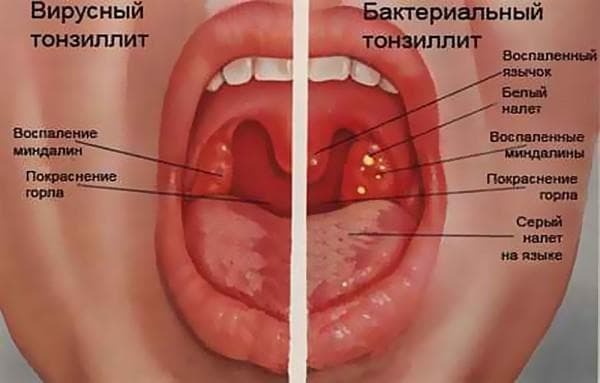
You can also recognize the ailment by the symptoms that are visited by the patient. To them it is possible to carry:
- a touch of light yellow shade on tonsils;
- body temperature rise;
- enlarged lymph nodes;
- soreness of the throat during swallowing;
- swelling of the throat;
- cough.
Sometimes the symptomatology may indicate a common cold, so many people do not rush to go to the hospital for examination. As a result, angina can be the result of severe complications or the transition of the ailment into a chronic form.
On the video - more information about bacterial sore:
How to distinguish bacterial angina from viral
What is the difference between viral angina and bacterial? What's the Difference? Doctors without additional diagnostics sometimes can not distinguish between viral and bacterial angina. Symptomatically, these two ailments are very similar. The difference between them is that the bacterial form of the disease is caused by bacteria( streptococcus), and the formation of a virus form is influenced by viruses.
In addition, in the treatment of viral sore throat, it is not advisable to use antibiotics, since they can not exert their influence. But with bacterial angina antibacterial drugs have a powerful effect and quickly eliminate the cause of the pathology.
As transmitted by
- Infection with bacterial sore throat can be by airborne droplets. This occurs when the affected person sneezes, and the nearby healthy inhaled the bacteria along with the air.
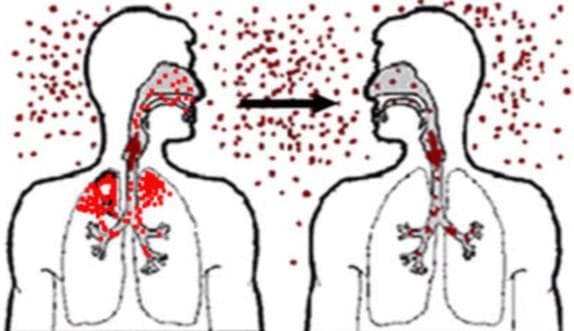
- Also the transfer of bacteria can be carried out through household items. Often such a disease affects small children who attend a kindergarten. It is there that they become infected from the affected children in the course of communication, common toys, and hugs.
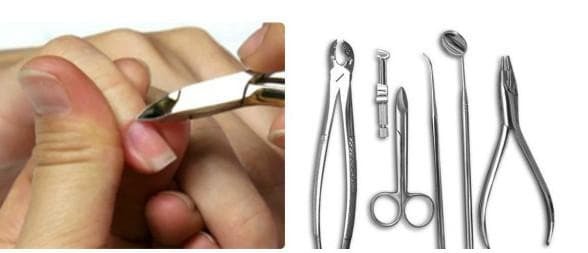
Here it is possible to read, how many days the tonsillitis is contagious. The link indicates the incubation period of angina.
Treatment in adults
How to treat? Eliminate the unpleasant symptoms of the disease and the very cause of bacterial sore throat in adult patients is possible with the help of complex treatment. As a rule, therapy includes mandatory medication. Here the doctor can prescribe antibacterial drugs, thanks to which it is possible to remove puffiness from the inflamed tonsils and bring their dimensions to the required parameters. Antibiotics should be administered no more than 7 days. But there are cases when antibiotic therapy should be increased.
Effective drugs for bacterial angina are:
- Penicillin,
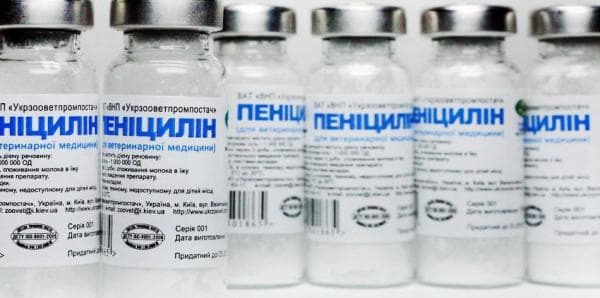
- Erythromycin,
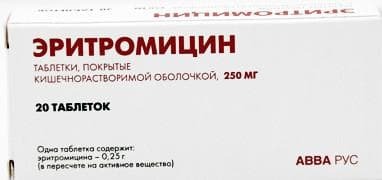
- Amoxicillin( described herein as treatment of angina with amoxicillin)
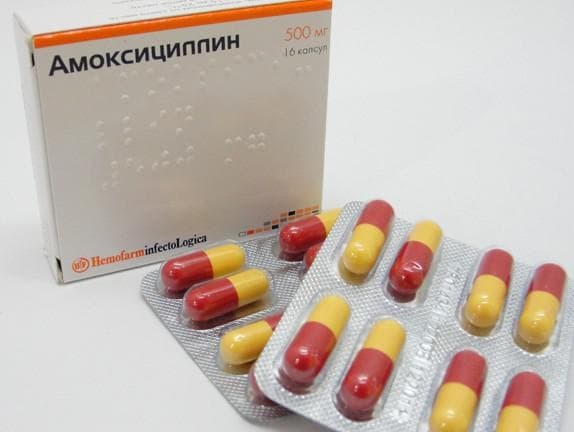
- Cephalosporins.
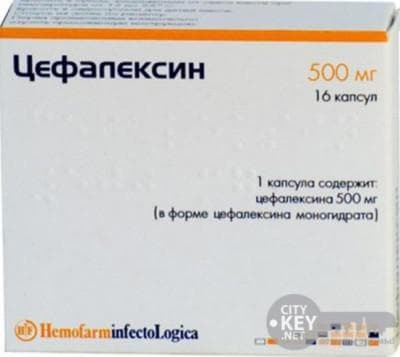
To eliminate pain and reduce temperature, the doctor will prescribe the patient Ibuprofen, Paracetamol, as well as analgesic lozenges.
The local methods of therapy include ultrasound or microwave .Thanks to this method, it is possible to quickly and effectively overcome the cause of the disease and alleviate the patient's condition. It is mandatory in the treatment regimen includes inhalation and rinsing of the mouth with a solution based on soda and herbs. 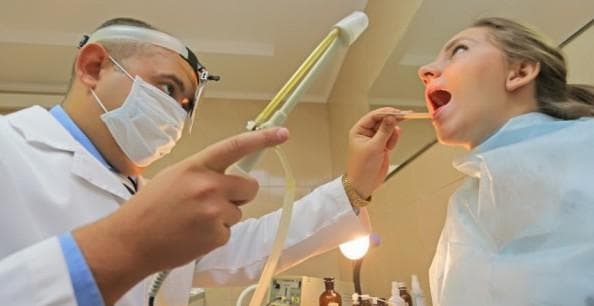
There are times when doctors turn to methods of alternative medicine. In this case, he prescribes to his patients the use of a large quantity of liquid without sugar. If you drink teas, then you can sweeten with honey, because it is characterized by the presence of excellent antibacterial properties. Propolis also has a positive effect. As a rule, when applied in the oral cavity, the patient feels a burning sensation. This sign indicates that bacterial asthma will soon leave the patient. The link details the treatment of tonsillitis with folk remedies.
No less effective is laser treatment. With the help of a laser it is possible to achieve an effective result. During such treatment, it is possible to partially remove or burn almond glands. To conduct such a procedure is necessary under local anesthesia. To obtain the desired result, it is enough to make several manipulations. 

Find out if there can be a cough with teething.
It describes how to take milk with soda from a cough.
Symptoms of bronchitis without fever: http: //prolor.ru/g/ simptomy-g / bronxita-u-vzroslogo-bez-temperatury.html.
Treatment in children
When the doctor diagnosed "bacterial angina", most often the treatment is based on the use of antibacterial drugs of the penicillin group. It is to such drugs streptococcus is sensitive. Most often the doctor prescribes to small patients such drugs:
- Penicillin,
- Amoxiclav in angina,
- Amoxicillin.
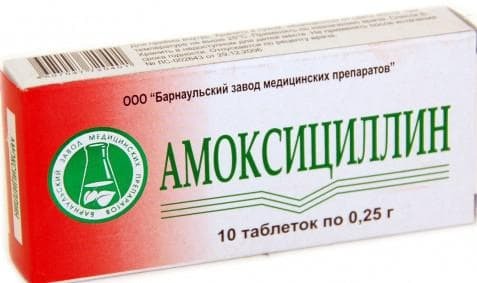
When a child is insensitive or allergic to these medications, the doctor should take care of substitutes, whose name is macrolides. These drugs are characterized by low toxicity, but they are very effective against microbes.
The most popular macrolides are:
- Sumamed( Sumamed dosage for angina is indicated here),
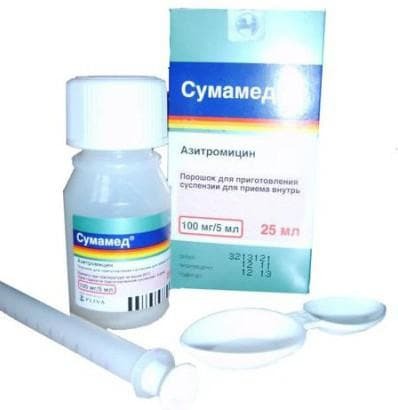
- Sitrorolide,
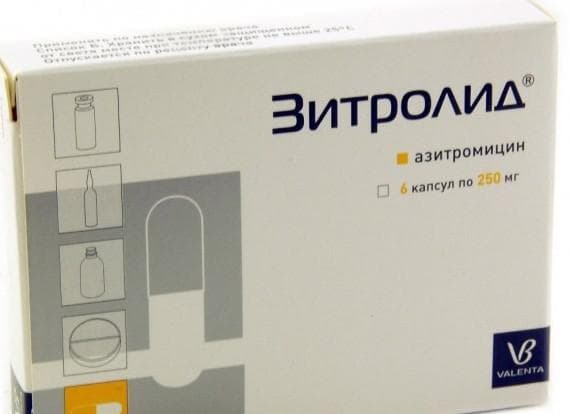
- Azidicide
- Chemomycin.
An antibacterial drug called Amoxicillin is sold in a pharmacy in various dosage forms: tablets, capsules and suspensions. Thanks to this, the drug is very popular in the treatment of bacterial sore throat in children.
Amoxiclav is a special form of the previous preparation. In its composition there is clavulanic acid, due to which it is possible to strengthen the effect of Amoxiclav during the therapy of infantile angina.
In addition to antibiotics, a doctor can prescribe vitamin therapy to his small patients. Such treatment is considered auxiliary, it is aimed at strengthening immune forces, as a result of which bacteria can not feel comfortable under the prevailing conditions.
In the course of treatment, vitamins C and B, antihistamines are used. Thanks to them, it is possible to slow down the spread of pathogenic microorganisms. Very often in the process can use a variety of immunocorrectors.
The video tells about bacterial sore throat in children:
Bacterial angina is a disease that mostly affects small children, but adults are also not immune from streptococcal disease. Nothing serious about this ailment leads to, if the treatment was made correctly and in a timely manner.
